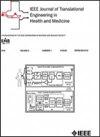利用静息神经生理数据的融合模型帮助大规模筛查甲基苯丙胺使用障碍
IF 4.4
3区 医学
Q2 ENGINEERING, BIOMEDICAL
IEEE Journal of Translational Engineering in Health and Medicine-Jtehm
Pub Date : 2024-12-25
DOI:10.1109/JTEHM.2024.3522356
引用次数: 0
摘要
甲基苯丙胺使用障碍(Methamphetamine use disorder, MUD)是一种物质使用障碍。由于COVID-19大流行使MUD变得更加普遍,因此提高MUD大规模筛查效率的替代方法非常重要。先前的研究使用虚拟现实(VR)诱导药物渴望时的脑电图(EEG)、心率变异性(HRV)和皮肤电反应(GSR)畸变来准确区分MUD患者和健康对照组。然而,这些异常是否没有引起药物提示反应,从而使患者与健康受试者分离,目前尚不清楚。在这里,我们提出了一种临床可比较的智能系统,该系统使用静息状态下的5通道EEG, HRV和GSR数据融合来帮助检测MUD。选取46例MUD患者和26例健康对照者,采用机器学习方法系统比较不同融合模型的分类结果。分析结果表明,HRV和GSR特征的融合使分离准确率达到79%。EEG、HRV和GSR特征的使用提供了更鲁棒的信息,导致不同分类器之间相对相似和提高的准确性。总之,我们证明了一个临床适用的智能系统,利用静息状态EEG, ECG和GSR特征,而不诱导药物线索反应性,可以增强对MUD的检测。该系统易于在临床环境中实施,可以节省大量的设置和实验时间,同时保持良好的准确性,以协助大规模筛查MUD。本文章由计算机程序翻译,如有差异,请以英文原文为准。
Fusion Model Using Resting Neurophysiological Data to Help Mass Screening of Methamphetamine Use Disorder
Methamphetamine use disorder (MUD) is a substance use disorder. Because MUD has become more prevalent due to the COVID-19 pandemic, alternative ways to help the efficiency of mass screening of MUD are important. Previous studies used electroencephalogram (EEG), heart rate variability (HRV), and galvanic skin response (GSR) aberrations during the virtual reality (VR) induction of drug craving to accurately separate patients with MUD from the healthy controls. However, whether these abnormalities present without induction of drug-cue reactivity to enable separation between patients and healthy subjects remains unclear. Here, we propose a clinically comparable intelligent system using the fusion of 5–channel EEG, HRV, and GSR data during resting state to aid in detecting MUD. Forty-six patients with MUD and 26 healthy controls were recruited and machine learning methods were employed to systematically compare the classification results of different fusion models. The analytic results revealed that the fusion of HRV and GSR features leads to the most accurate separation rate of 79%. The use of EEG, HRV, and GSR features provides more robust information, leading to relatively similar and enhanced accuracy across different classifiers. In conclusion, we demonstrated that a clinically applicable intelligent system using resting-state EEG, ECG, and GSR features without the induction of drug cue reactivity enhances the detection of MUD. This system is easy to implement in the clinical setting and can save a lot of time on setting up and experimenting while maintaining excellent accuracy to assist in mass screening of MUD.
求助全文
通过发布文献求助,成功后即可免费获取论文全文。
去求助
来源期刊

IEEE Journal of Translational Engineering in Health and Medicine-Jtehm
Engineering-Biomedical Engineering
CiteScore
7.40
自引率
2.90%
发文量
65
审稿时长
27 weeks
期刊介绍:
The IEEE Journal of Translational Engineering in Health and Medicine is an open access product that bridges the engineering and clinical worlds, focusing on detailed descriptions of advanced technical solutions to a clinical need along with clinical results and healthcare relevance. The journal provides a platform for state-of-the-art technology directions in the interdisciplinary field of biomedical engineering, embracing engineering, life sciences and medicine. A unique aspect of the journal is its ability to foster a collaboration between physicians and engineers for presenting broad and compelling real world technological and engineering solutions that can be implemented in the interest of improving quality of patient care and treatment outcomes, thereby reducing costs and improving efficiency. The journal provides an active forum for clinical research and relevant state-of the-art technology for members of all the IEEE societies that have an interest in biomedical engineering as well as reaching out directly to physicians and the medical community through the American Medical Association (AMA) and other clinical societies. The scope of the journal includes, but is not limited, to topics on: Medical devices, healthcare delivery systems, global healthcare initiatives, and ICT based services; Technological relevance to healthcare cost reduction; Technology affecting healthcare management, decision-making, and policy; Advanced technical work that is applied to solving specific clinical needs.
 求助内容:
求助内容: 应助结果提醒方式:
应助结果提醒方式:


